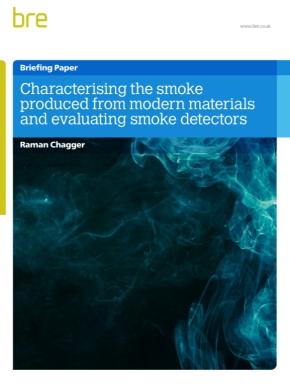Characterising smoke from modern materials and evaluating smoke detectors
Characterising smoke from modern materials and evaluating smoke detectors was written by Raman Chagger and published by BRE in 2014.
The object of this research was to investigate the smoke profiles generated in fire tests specified in the EN 54-7 (commercial) and EN 14604 (domestic) smoke detector standards, and to compare them with smoke produced from burning or smouldering materials commonly found in today‘s service environment.
The four test fires used to assess smoke detectors were developed in the 1980s and represent a broad range of smoke types expected in commercial and domestic environments at the time. However, the materials used in modern homes have changed significantly in recent decades. This research investigated whether smoke detectors could respond to the smoke produced from those new materials during a fire.
The smoke characteristics for a range of new materials were measured and compared with the four test fires. The performance of approved ionisation and optical smoke detectors to the smoke produced from these materials was also assessed. It was confirmed that both ionisation and optical smoke detectors are attuned to detecting certain types of fires and that existing standards remain suitable for assessing these technologies.
The knowledge gained from this study enabled more challenging test fires to be developed that were used during multi-sensor research work.
The contents of the briefing paper are:
- Abstract.
- Introduction.
- Background.
- The current test fires.
- Methodology.
- Results.
- Analysis.
- Summary of results.
- Conclusions and recommendations for further research.
- References.
- Acknowledgements.
You can download the briefing paper at: https://files.bregroup.com/research/Test-Fires-Characterisation_2014-November.pdf
[edit] Related articles on Designing Buildings Wiki
Featured articles and news
RTPI leader to become new CIOB Chief Executive Officer
Dr Victoria Hills MRTPI, FICE to take over after Caroline Gumble’s departure.
Social and affordable housing, a long term plan for delivery
The “Delivering a Decade of Renewal for Social and Affordable Housing” strategy sets out future path.
A change to adoptive architecture
Effects of global weather warming on architectural detailing, material choice and human interaction.
The proposed publicly owned and backed subsidiary of Homes England, to facilitate new homes.
How big is the problem and what can we do to mitigate the effects?
Overheating guidance and tools for building designers
A number of cool guides to help with the heat.
The UK's Modern Industrial Strategy: A 10 year plan
Previous consultation criticism, current key elements and general support with some persisting reservations.
Building Safety Regulator reforms
New roles, new staff and a new fast track service pave the way for a single construction regulator.
Architectural Technologist CPDs and Communications
CIAT CPD… and how you can do it!
Cooling centres and cool spaces
Managing extreme heat in cities by directing the public to places for heat stress relief and water sources.
Winter gardens: A brief history and warm variations
Extending the season with glass in different forms and terms.
Restoring Great Yarmouth's Winter Gardens
Transforming one of the least sustainable constructions imaginable.
Construction Skills Mission Board launch sector drive
Newly formed government and industry collaboration set strategy for recruiting an additional 100,000 construction workers a year.
New Architects Code comes into effect in September 2025
ARB Architects Code of Conduct and Practice available with ongoing consultation regarding guidance.
Welsh Skills Body (Medr) launches ambitious plan
The new skills body brings together funding and regulation of tertiary education and research for the devolved nation.
Paul Gandy FCIOB announced as next CIOB President
Former Tilbury Douglas CEO takes helm.
UK Infrastructure: A 10 Year Strategy. In brief with reactions
With the National Infrastructure and Service Transformation Authority (NISTA).
























